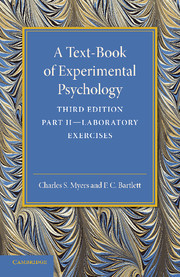Description
A Text-Book of Experimental Psychology: Volume 2, Laboratory Exercises
With Laboratory Exercises
Authors: Myers Charles S., Bartlett F. C.
First published in 1925, this second volume of Dr Charles Myers' two-part textbook suggests practical experiments to test psychological phenomena.
Language: English
Subject for A Text-Book of Experimental Psychology: Volume 2...:
Approximative price 32.87 €
In Print (Delivery period: 14 days).
Add to cart
Publication date: 12-2013
Support: Print on demand
Support: Print on demand
Description
/li>Contents
/li>
First published in 1925 as the third edition of a 1911 original, this second volume of Dr Charles Myers' two-part textbook suggests practical experiments to test psychological phenomena, such as reaction times and optical illusions. This book will be of value to anyone with an interest in the history of experimental psychology, or the work of Myers, one of the most ground-breaking English psychologists of the twentieth century.
1. Introductory; 2. Free association; 3. Perception and reproduction of forms; 4. Recognition and recall; 5. Process of construction; 6. Process of analysis; 7. Method of mean error; 8. Limiting method; 9. Method of serial groups; 10. Constant method; 11. Method of equal appearing intervals; 12. Experiences of identity and difference; 13. Absolute impression; 14. Equal-appearing intervals of brightness; 15. Reaction times; 16. Simple and composite reactions; 17. Heat and cold spots; 18. Colour vision; 19. Visual acuity; 20. Auditory experience; 21. Perception of form and size; 22. Perception of distance and movement; 23. Span of attention; 24. Imaging; 25. Memory; 26. Muscular and mental fatigue; 27. Mental tests; 28. Cutaneous and thermal sensations; 29. Labyrinthine and motor sensations; 30. Gustatory sensations; 31. Olfactory sensations; 32. Visual sensations; 33. Auditory sensations; 34. Olfactory sensations; 35. Sensory adaptation; 36. Tactual localisation; 37. Binocular experience; 38. Optical illusions; 39. Estimation of time intervals; 40. Rhythm; 41. The memory image; 42. Muscular practice; 43. Fluctuations of attention; 44. Expression of feeling; 45. Statistical methods.
© 2024 LAVOISIER S.A.S.




